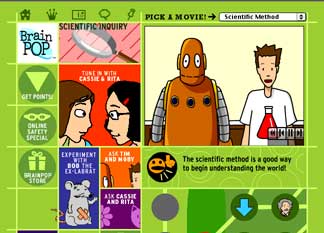|
|
1. The Scientific Method
At this point, I knew that
it was important to organize this unit into a framework.
What, exactly had the Doctor done? He saw a problem,
collected data, made a suggestion/hypothesis and tested
his theory. He had used the Scientific Method! Here was a
chance to approach a real problem as
"scientists." I reviewed the Scientific Method
with the class. What is it? How can we use it? I wanted
this unit to provide the students with a "real"
opportunity to understand how this method works.
Students should understand:
Observation
Hypothesis
Prediction
Experiment
Data
Testable
For a great animated introduction to
the scientific method, I sent my students to the
computers to find: Brainpop.com . This
is a wonderful site for reviewing and understanding the
four steps used by scientists.
WARNING!: Currently, Brainpop allows one
"free" visit per computer per day. Your
students can view the film more than once when they
access the site. But, if they attempt to log on after
signing off, free access will be denied.
HINT:
A. Have the students take the "Quiz"
before they watch the movie.
B. Encourage students to note any questions or new ideas.
(In the computer lab, I will often group students using
two computers for each group. One computer is used
strictly for taking notes while the other computer is
used for a specific activity.)

2. Now, use this
chart to assess your students' understanding of the
Scientific Method.
 r r
For those students who wanted to
explore this further, I suggested: http://teacher.nsrl.rochester.edu/phy_labs/AppendixE/AppendixE.html
This site, created by Rochester University Professor,
Frank Wolf, goes into greater detail about the Scientific
Method but was understood by my students.
3. Class Discussion: Did Dr. Renshaw use the Scientific Method? How?
What was his Observation? Hypothesis? Prediction?
Experiment?
(I found that my students were able to apply the steps of
the scientific method easily to this study. The doctor observed
a problem with pedestrian safety, hypothesized
that he could make improvements, predicted that
this would improve safety and ran his experiment over
six years.)
4. For Homework, as a method of quick assessment, the students
were asked to create a simple written explanation of the
Scientific Method. Answers were based on our Internet
search and could also include information from our school
science text. These were reviewed and discussed during
the following class session. (As the unit progressed, we
ran into a number of problems being "faithful"
to the Scientific Method. At times, there were too many
variables in the data we collected. In spite of this, the
children and I learned as much by our mistakes as by our
successes.)
|

 Next page
Next page
 Next page
Next page